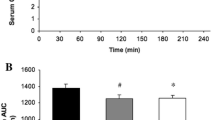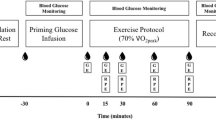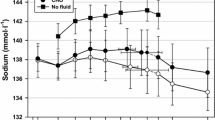Summary
The influence of a pattern of exercise and dietary manipulation, intended to alter carbohydrate (CHO) availability, on pre-exercise acid-base status and plasma ammonia and blood lactate accumulation during incremental exercise was investigated. On three separate occasions, five healthy male subjects underwent a pre-determined incremental exercise test (IET) on an electrically braked cycle ergometer. Each IET involved subjects exercising for 5 min at 30%, 50%, 70% and 95% of their maximal oxygen uptake (\(\dot VO_{2max}\)) and workloads were separated by 5 min rest. The first IET took place after 3 days of normal dietary CHO intake. The second and third tests followed 3 days of low or high CHO intake, which was preceded by prolonged exercise to exhaustion in an attempt to deplete muscle and liver glycogen stores. Acid-base status and plasma ammonia and blood lactate levels were measured on arterialised venous blood samples immediately prior to and during the final 15 s of exercise at each workload and for 40 min following the completion of each IET. Three days of low CHO intake resulted in the development of a mild metabolic acidosis in all subjects. Plasma ammonia (NH3) accumulation on the low-CHO diet tended to be greater than normal at each exercise workload. Values returned towards resting levels during each recovery period. After the normal and high-CHO diets plasma NH3 levels did not markedly increase above resting values until after exercise at 95% \(\dot VO_{2max}\). Plasma NH3 levels after the high-CHO diet were similar to those after the normal CHO diet. Blood lactate levels did not markedly increase with each treatment until after exercise at 70% \(\dot VO_{2max}\). There was a trend for blood lactate accumulation after the low-CHO diet to be lower than that after the normal and high-CHO diets during the IET and for the majority of the recovery period. Levels after the high-CHO diet tended to be similar to those after the normal diet. The present experiment demonstrates that an alteration in pre-exercise substrate availability will influence the accumulation of plasma NH3 during exercise. In this situation, the use of plasma NH3 as an index of exercise intensity and the onset of fatigue should be viewed with some caution.
Similar content being viewed by others
References
Åstrand P-O, Rodahl K (1977) Textbook of work physiology. McGraw-Hill, New York
Babij P, Matthews SM, Rennie MJ (1983) Changes in blood ammonia, lactate and amino acids in relation to workload during bicycle ergometer exercise in man. Eur J Appl Physiol 50:405–411
Bergström J, Hermansen L, Hultman E, Saltin B (1967) Diet, muscle glycogen and physical performance. Acta Physiol Scand 71:140–150
Borg G (1974) Psychological aspects of physical activities. In: Larsen LA (ed) Fitness, health and work capacity. Macmillan, New York, p 141
Broberg S, Sahlin K (1988) Hyperammonaemia during prolonged repeated submaximal exercise: an effect of glycogen depletion. J Appl Physiol 65:2475–2477
Broberg S, Sahlin K (1989) Adenine nucleotide degradation in human skeletal muscle during prolonged exercise. J Appl Physiol 67:116–122
Buse MG, Biggers JF, Friedrici KH, Buse JF (1972) Oxidation of branched chain amino acids by isolated hearts and diaphragms of the rat. The effect of fatty acids, glucose, and pyruvate respiration. J Biol Chem 247:8085–8096
Dill DB, Costill DL (1974) Calculation of percentage changes in volumes of blood, plasma and red cells in dehydration. J Appl Physiol 37:247–248
Dudley GA, Staron RS, Murray TF, Hagerman FC, Luginbuhl A (1983) Muscle fibre composition and blood ammonia levels after intense exercise in humans. J Appl Physiol 54:582–586
Forster HV, Dempsey JA, Thomson J, Vidruk R, DoPico GA (1972) Estimation of arterial PO2, PCO2, pH and lactate from arterialised venous blood. J Appl Physiol 32:134–137
Graham TE, Pedersen PK, Saltin B (1987) Muscle and blood ammonia and lactate responses to prolonged exercise with hyperoxia. J Appl Physiol 63:1457–1462
Greenhaff PL, Gleeson M, Maughan RJ (1988) The effects of diet on muscle pH and metabolism during high intensity exercise. Eur J Appl Physiol 57:531–539
Hageloch W, Schneider S, Weicker H (1990) Blood ammonia determination in a specific field test as a method supporting talent selection in runners. Int J Sports Med 11 [Suppl 2]:S56-S61
Harris RC, Marlin DJ, Snow DH (1987) Metabolic response to maximal exercise of 800 and 2000 m in the thoroughbred horse. J Appl Physiol 63:12–19
Harris RC, Marlin DJ, Snow DH, Harkness RA (1991) Muscle ATP loss and lactate accumulation at different work intensities in the exercising thoroughbred horse. Eur J Appl Physiol 62:235–244
Hultman E (1967) Studies on muscle metabolism of glycogen and active phosphate in man with special reference to exercise and diet. Scand J Clin Lab Invest 19 [Suppl 94]:1–63
Hultman E, Spriet LL, Söderlund K (1987) Energy metabolism and fatigue in working muscle. In: Macleod D, Maughan R, Nimmo M, Reilly T, Williams C (eds) Exercise: benefits, limits and adaptations. Spon, London, pp 63–84
Katz A, Sahlin K, Henriksson J (1986) Muscle ammonia metabolism during isometric contraction in humans. Am J Physiol 250:C834-C840
Lemon PWR, Mullin JP (1980) The effect of initial muscle glycogen levels on protein catabolism during exercise. J Appl Physiol 48:624–629
Lowenstein JM (1972) Ammonia production in muscle and other tissues: the purine nucleotide cycle. Physiol Rev 52:382–414
Maughan RJ (1982) A simple rapid method for the determination of glucose, lactate, pyruvate, alanine, 3-hydroxybutyrate and acetoacetate on a single 20 μl blood sample. Clin Chim Acta 122:231–240
Maughan RJ, Williams C, Campbell DM, Hepburn D (1978) Fat and carbohydrate metabolism during low intensity exercise: effects of availability of muscle glycogen. Eur J Appl Physiol 39:7–16
Meyer RA, Dudley GA, Terjung RL (1980) Ammonia and IMP in different skeletal muscle fibres after exercise in rats. J Appl Physiol 49:1037–1041
Millward DJ, Davies CTM, Halliday D, Wolman SL, Matthews D, Rennie MJ (1982) Effect of exercise on protein metabolism in humans as explored with stable isotopes. Fed Proc 41:2686–2691
Newsholme EA, Leech AR (1983) Biochemistry of the medical sciences. Wiley, Chichester
Norman B, Sollevi A, Jansson E (1988) Increased IMP content in glycogen-depleted muscle fibres during submaximal exercise in man. Acta Physiol Scand 133:977–1000
Owen EE, Robinson RR (1963) Amino acid extraction and ammonia metabolism by the human kidney during prolonged administration of ammonium chloride. J Clin Invest 42:263–276
Paul AA, Southgate DAT (1988) McCane and Widdowson's, The composition of foods, 4th edn. HMSO, London; Elsevier/North Holland, New York
Poortmans JR (1988) Protein metabolism. In: Poortmans JR (ed) Principles of exercise biochemistry. Karger, Basel, pp 164–193
Rennie MJ, Halliday D, Davies CTM, Edwards RHT, Krywawych S, Millward DJ, Matthews DE (1981) Exercise induced increase in leucine oxidation in man and the effect of glucose. In: Walser M, Williamson JR (eds) Metabolism and clinical implications of branched chain amino and ketoacids. Elsevier/North Holland, New York, pp 361–366
Sahlin K, Broberg S (1990) Adenine nucleotide depletion in human muscle during exercise: causality and significance of AMP deamination. Int J Sports Med 11 [Suppl 2]:S62-S67
Sahlin K, Katz A (1988) Purine nucleotide metabolism. In: Poortmans J (ed) Principles of exercise biochemistry. Karger, Basel, pp 120–139
Schlicht W, Naretz W, Witt D, Rieckert H (1990) Ammonia and lactate: differential information on monitoring training load in sprint events. Int J Sports Med 11 [Suppl 2]:S85-S90
Siggaard-Andersen O (1963) Blood acid-base alignment monogram. Scales for pH, PCO2, base excess of whole blood of different haemoglobin concentrations, plasma bicarbonates and plasma total-CO2. Scand J Clin Lab Invest 15:211–217
Snow DH, Harris RC, Gash S (1985) Metabolic response of equine muscle to intermittent maximal exercise. J Appl Physiol 5:1689–1697
Wagemakers AJM, Brooks JH, Coakley JH, Reilly T, Edwards RHT (1989) Exercise induced activation of branched chain 2 oxo acid dehydrogenase in human muscle. Eur J Appl Physiol 59:159–167
Wagenmakers AJM, Coakley JH, Edwards RHT (1990) Metabolism of branched chain amino acids and ammonia during exercise: clues from McArdle's disease. Int J Sports Med 11 [Suppl 2]:S1O1-S113
Author information
Authors and Affiliations
Rights and permissions
About this article
Cite this article
Greenhaff, P.L., Leiper, J.B., Ball, D. et al. The influence of dietary manipulation on plasma ammonia accumulation during incremental exercise in man. Eur J Appl Physiol 63, 338–344 (1991). https://doi.org/10.1007/BF00364459
Accepted:
Issue Date:
DOI: https://doi.org/10.1007/BF00364459




